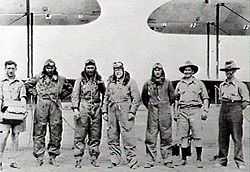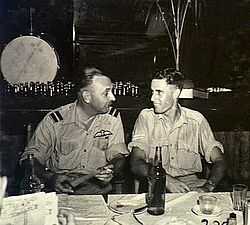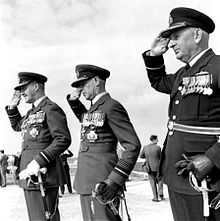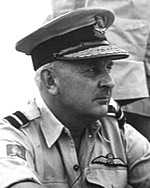Alan Charlesworth
| Alan Moorehouse Charlesworth | |
|---|---|
|
Air Commodore Charlesworth in Japan, c. 1949 | |
| Born |
17 September 1904 Lottah, Tasmania |
| Died |
21 September 1978 (aged 75) Glen Iris, Victoria |
| Allegiance | Australia |
| Service/branch |
Australian Army Royal Australian Air Force |
| Years of service | 1920–55 |
| Rank | Air Vice Marshal |
| Unit |
2nd Light Horse Regiment (1924) No. 1 Squadron (1925–28, 1930–32, 1934–39) No. 2 Group (1939–40) BCOF (1949–51) |
| Commands held |
No. 2 Squadron (1939) RAAF Station Pearce (1940–41) Eastern Area (1943–44, 1946) North-Western Area (1944–46) Land/Air Warfare School (1947–49) RAAF Station Williamtown (1949) Southern Area (1951–53) RAAF Overseas Headquarters (1954–55) |
| Battles/wars |
World War II Korean War |
| Awards |
Commander of the Order of the British Empire Air Force Cross |
| Other work |
Director of Recruiting Supreme court judge's associate |
Air Vice Marshal Alan Moorehouse Charlesworth, CBE, AFC (17 September 1903 – 21 September 1978) was a senior commander in the Royal Australian Air Force (RAAF). Born in Tasmania, he graduated from the Royal Military College, Duntroon, and served with the 2nd Light Horse Regiment in Queensland before transferring to the Air Force in 1925. Most of his pre-war flying career was spent with No. 1 Squadron at RAAF Station Laverton, Victoria. In 1932 he undertook a series of survey flights around Australia, earning the Air Force Cross. Charlesworth's early wartime commands included No. 2 Squadron at Laverton, and RAAF Station Pearce in Western Australia. Appointed Air Officer Commanding (AOC) RAAF Eastern Area in December 1943, he was promoted temporary air commodore the following year and took over as AOC RAAF North-Western Area in Darwin, Northern Territory.
Charlesworth's control of air operations during the North Western Area Campaign led to his appointment as a Commander of the Order of the British Empire following the end of World War II. Retaining his wartime rank, he took charge of the newly formed School of Land/Air Warfare from 1947 until 1949, when he assumed command of RAAF Station Williamtown, New South Wales. He was posted to Japan later that year as Chief of Staff, British Commonwealth Occupation Force, and organised support for RAAF units involved in the Korean War. Returning to Australia in 1951, he was raised to acting air vice marshal and became AOC RAAF Southern Area. Charlesworth's final appointment before retiring from the Air Force was commanding RAAF Overseas Headquarters, London, in 1954–55. After leaving the military he served as Director of Recruiting in the late 1950s, and later as a judge's associate at the Supreme Court of Victoria. He died at his home in Glen Iris, Victoria, in 1978.
Early career
Born in Lottah, Tasmania, on 17 September 1903, Alan Charlesworth was the son of a storeman, Edwin Charlesworth, and his wife Louisa.[1] The youth attended Lottah Public School and St Virgil's College, Hobart, before entering the Royal Military College, Duntroon, in 1920.[2] He won the Silver Boomerang trophy, awarded to the college's champion athlete, three years running in 1921–23.[3] In 1923 he was appointed company sergeant major at Duntroon, and received the Sword of Honour upon graduating as a lieutenant later that year.[1][4] Following service as adjutant and quartermaster with the 2nd Light Horse Regiment in Queensland, Charlesworth transferred to the Royal Australian Air Force (RAAF) as a flying officer on 27 January 1925.[5][6] Among his classmates on the 1925 pilots' course at Point Cook, Victoria, was fellow Duntroon graduate Frederick Scherger.[7] During a training flight on 25 March, Charlesworth's Avro 504K stalled and spun into a field, injuring him and killing his instructor.[1][8] Recovering, he was subsequently involved in an accident with future lieutenant general and Governor of New South Wales Eric Woodward, when their plane flipped on landing and came to rest upside down on a fence; neither man was badly hurt.[9]

Charlesworth graduated as a pilot in July 1925, and was posted to No. 1 Squadron at RAAF Station Laverton, Victoria.[1] In January 1926, he took part in experiments to test parachutes by attaching them to dummies and throwing them out of aircraft in flight.[10] His secondment to the Air Force was made permanent in January 1928, and he was promoted to flight lieutenant the following month. On 30 April, Charlesworth married Edith Bennett at All Saints Anglican Church, St Kilda; the couple had a daughter.[1] The next month, he was posted to the United Kingdom on attachment to the Royal Air Force (RAF). He attended the RAF School of Photography at Farnborough, before serving with the RAF Survey Flight in British Somaliland during 1929–30.[1] Returning to Australia he was again posted to No. 1 Squadron, taking command of a round-Australia aerial survey conducted in three phases during 1932 in association with the Commonwealth Geologist, Doctor Walter Woolnough. Charlesworth's study in Britain and his experience in Somaliland had made him the RAAF's leading expert in photographic reconnaissance, which was to be utilised in the search for potential oil fields.[11]
The first phase of the survey took place in January–February, employing two Westland Wapitis and seven other Air Force personnel from Nos. 1 and 3 Squadrons to photograph sites in southern Queensland. Despite both aircraft being damaged in a gale at Bourke in northern New South Wales while returning to base, the expedition was considered a success.[11][12] For the second phase, lasting from July to September, Charlesworth and his team journeyed around the whole of Australia from New South Wales to Queensland, thence to the Northern Territory and Western Australia, before returning to Laverton. The final phase in December explored Tasmania. Charlesworth was awarded the Air Force Cross (AFC) for his leadership of the survey, described as a "milestone" in the country's exploration.[11][13] Following his survey work, Charlesworth was appointed Staff Officer Photography at RAAF Headquarters, Melbourne.[14] In 1934 he returned to Laverton to take up his third and final posting with No. 1 Squadron.[2] By September 1937, he had been raised to Squadron Leader and was in temporary command of the unit.[2][15] He had overall charge of a training flight in November–December that ended in disaster, when a Hawker Demon crashed near Cootamundra, New South Wales, and its pilot burned to death; this was one of a spate of incidents during the year that led to serious questions being raised about the level of flying safety in the RAAF.[1][16] In March 1939, Charlesworth was raised to wing commander and took command of No. 2 Squadron, operating Avro Ansons out of Laverton.[1][17]
World War II

As part of the RAAF's reorganisation following the outbreak of World War II in September 1939, No. 2 Group was formed in Sydney on 20 November; Charlesworth was appointed its Senior Air Staff Officer (SASO).[2][18] He continued to serve in this position when the group was reformed as Central Area in March 1940.[2][19] Posted to Western Australia to take command of RAAF Station Pearce in August, he was promoted to temporary group captain on 1 September 1940.[5][20] He became Senior Administration Officer at the newly established Western Area, Perth, in January the following year.[2][21] In September 1942, Charlesworth took over No. 2 Bombing and Gunnery School in Sale, Victoria. He handed over to Group Captain Charles "Moth" Eaton in August 1943, before briefly taking charge of RAAF Headquarters Forward Echelon in Brisbane.[2][22] Charlesworth was appointed Air Officer Commanding (AOC) Eastern Area, headquartered at Bradfield Park, Sydney, in December 1943.[23] Eastern Area was responsible for maritime patrol and anti-submarine warfare off the coast of New South Wales and southern Queensland. Japanese submarine activity had decreased in the months prior to Charlesworth taking command, and he was concerned that Allied ships were becoming complacent. He observed "a general slackening off in procedure; ships are seldom where they should be, and a minority of merchant ships identify themselves to aircraft". However, the RAAF's patrols had also settled into a predictable pattern which would have been easy for an observant submarine captain to avoid.[24][25]
Charlesworth was promoted to temporary air commodore on 1 August 1944. The following month he was appointed AOC North-Western Area (NWA) in Darwin, Northern Territory, replacing Air Vice Marshal Adrian "King" Cole.[1][26] By this stage of the war, the Allies were advancing north and the tempo of operations in the Darwin area had decreased.[27] Charlesworth immediately raised concerns regarding No. 80 Wing, which operated three squadrons of Spitfire fighters, warning higher command that its morale could drop if it was not either given a more active role in the war or transferred to southern Australia for rest.[28] By October, the wing had received orders to depart NWA for the forward base of Morotai to join the RAAF's main mobile strike force, First Tactical Air Force; this move would leave Charlesworth with twelve squadrons at his disposal, including one B-24 Liberator heavy bomber unit and three other Spitfire squadrons.[29][30] In the meantime, NWA supported the assault on Leyte with attacks on enemy ports, oil facilities, and shipping in the Dutch East Indies using Beaufighters, B-25 Mitchells, and Liberators. These operations continued through November–December.[31] In April 1945, Charlesworth sent Mitchells and Liberators against a Japanese convoy led by the cruiser Isuzu; the bombers damaged the cruiser, and it was subsequently sunk by Allied submarines.[32] The same month, NWA's Liberators attacked targets in Java in the lead-up to the Battle of Tarakan that commenced on 1 May.[33] By July, Charlesworth's area command had been denuded of much of its strength as two of its bomber wings were transferred to First Tactical Air Force.[34]
Postwar career

Among a small coterie of wartime RAAF commanders considered suitable for further senior roles, Charlesworth retained his rank of air commodore following the cessation of hostilities.[35][36] He was appointed a Commander of the Order of the British Empire (CBE) in the 1946 King's Birthday Honours for his "conspicuous service in operations against the Japanese" while leading North-Western Area Command.[37][38] The same year, he relinquished command of North-Western Area and briefly took charge of Eastern Area Command. He then posted to Britain to undertake a course at the RAF School of Air Support.[2] Returning to Australia, he became the inaugural Commandant of the School of Land/Air Warfare at Laverton in April 1947.[2][39] The school transferred to RAAF Station Williamtown, New South Wales, the following year.[40] Charlesworth took overall command of Williamtown in 1949.[2] In June that year, he succeeded fellow Duntroon graduate Air Commodore John McCauley as Chief of Staff to the British Commonwealth Occupation Force (BCOF) in Japan.[41]
Charlesworth's workload at BCOF increased considerably with the outbreak of the Korean War in June 1950 and the need to supply the RAAF's contribution to the conflict, chiefly No. 77 Squadron.[42] In October, following the death in combat of Squadron Leader Lou Spence, Charlesworth temporarily transferred from Tokyo to Iwakuni so that he could administer No. 77 Squadron and its ancillaries until No. 91 (Composite) Wing was formed to take over the task.[43] Upon his return to Australia in June 1951, he was promoted to acting air vice marshal and appointed AOC Southern Area, headquartered in Albert Park, Melbourne. Towards the end of his tenure, the RAAF's wartime area command system was transformed into a structure based on function rather than geography. As a result, Southern Area was reformed as Training Command in October 1953.[44][45][46] In 1954 he returned to the UK to command RAAF Overseas Headquarters, London.[45] Completing his term in London, Charlesworth retired from the Air Force on 31 December 1955, and was made an honorary air vice marshal the following year.[1][47] He was then appointed a technical advisor to the committee organising the 1956 Summer Olympics in Melbourne.[48] In 1958–59, he served as Director of Recruiting Combined Services, and later became a judge's associate with the Supreme Court of Victoria.[2][49] In retirement he made his home in Glen Iris, Victoria, where he died on 21 September 1978. Survived by his wife and daughter, he was accorded an Air Force funeral and cremated.[1]
Notes
- ↑ 1.0 1.1 1.2 1.3 1.4 1.5 1.6 1.7 1.8 1.9 1.10 Charlesworth, Alan Moorehouse (1903–1978) at Australian Dictionary of Biography. Retrieved on 10 January 2011.
- ↑ 2.0 2.1 2.2 2.3 2.4 2.5 2.6 2.7 2.8 2.9 2.10 Honorary Air Vice-Marshals at Royal Australian Air Force. Retrieved on 10 January 2011.
- ↑ Moore, Duntroon, pp. 329, 339
- ↑ O'Neill, Australia in the Korean War, p. 630
- ↑ 5.0 5.1 "PEARCE AIR FORCE STATION.". The West Australian (Perth: National Library of Australia). 21 August 1940. p. 6. Retrieved 16 January 2011.
- ↑ Gillison, Royal Australian Air Force 1939–1942, p. 712
- ↑ Coulthard-Clark, The Third Brother, p. 192
- ↑ Coulthard-Clark, The Third Brother, pp. 315–316
- ↑ Coulthard-Clark, The Third Brother, pp. 125–126
- ↑ Coulthard-Clark, The Third Brother, p. 337
- ↑ 11.0 11.1 11.2 Coulthard-Clark, The Third Brother, pp. 424–427
- ↑ Roylance, Air Base Richmond, pp. 38–39
- ↑ The London Gazette: (Supplement) no. 33946. p. 3816. 3 June 1933. Retrieved 10 January 2011.
- ↑ Coulthard-Clark, The Third Brother, p. 429
- ↑ Coulthard-Clark, The Third Brother, p. 343
- ↑ Coulthard-Clark, The Third Brother, pp. 344–346
- ↑ 2 Squadron RAAF at Australian War Memorial. Retrieved on 10 January 2011.
- ↑ Gillison, Royal Australian Air Force 1939–1942, p. 67
- ↑ Gillison, Royal Australian Air Force 1939–1942, pp. 91–92
- ↑ Ashworth, How Not to Run an Air Force, p. 290
- ↑ "R.A.A.F. Commands". The Mercury (Hobart, Tas.: National Library of Australia). 4 January 1941. p. 5. Retrieved 16 January 2011.
- ↑ RAAF Historical Section, Units of the Royal Australian Air Force, p. 12
- ↑ Ashworth, How Not to Run an Air Force, p. 303
- ↑ Odgers, Air War Against Japan, p. 349
- ↑ Stevens, A Critical Vulnerability, p. 258
- ↑ Ashworth, How Not to Run an Air Force, p. 291
- ↑ Horner, "The Evolution of Australian Higher Command Arrangements", pp. 17–18
- ↑ Odgers, Air War Against Japan, pp. 246–247
- ↑ Odgers, Air War Against Japan, pp. 297–299
- ↑ Odgers, Air Force Australia, p. 121
- ↑ Odgers, Air War Against Japan, pp. 301–302, 313–316
- ↑ Odgers, Air War Against Japan, pp. 407–409
- ↑ Odgers, Air War Against Japan, pp. 451–455
- ↑ Odgers, Air War Against Japan, pp. 476–477
- ↑ Stephens, Going Solo, pp. 24–25
- ↑ Helson, Ten Years at the Top, p. 238–239
- ↑ Recommended: Commander of the Order of the British Empire at Australian War Memorial. Retrieved on 10 January 2011.
- ↑ The London Gazette: (Supplement) no. 37625. p. 3217. 25 June 1946. Retrieved 10 January 2011.
- ↑ "Three Services to Attend New Air Support School". The Sydney Morning Herald (National Library of Australia). 29 April 1947. p. 5. Retrieved 10 January 2011.
- ↑ Joint Warfare, Doctrine and Training Centre at Department of Defence. Retrieved on 14 January 2011.
- ↑ Stephens, The Royal Australian Air Force, p. 213
- ↑ O'Neill, Australia in the Korean War, p. 309
- ↑ O'Neill, Australia in the Korean War, p. 314
- ↑ "To Command R.A.A.F. Here". The Age (Melbourne: Google News). 30 June 1951. p. 4. Retrieved 16 January 2011.
- ↑ 45.0 45.1 Dennis et al., Oxford Military History of Australia, p. 127
- ↑ Stephens, Going Solo, pp. 71–76
- ↑ Charlesworth, Alan Moorehouse at World War 2 Nominal Roll. Retrieved on 10 January 2011.
- ↑ "RECRUITING LAG MAY END IN 1965". The Sydney Morning Herald (Sydney: Google News). 8 January 1958. p. 15. Retrieved 16 January 2011.
- ↑ Alexander, Who's Who in Australia 1962, p. 169
References
| Wikimedia Commons has media related to Alan Charlesworth (RAAF officer). |
- Alexander, Joseph A. (ed.) (1962). Who's Who in Australia 1962. Melbourne: Colorgravure. OCLC 686119704.
- Ashworth, Norman (2000). How Not to Run an Air Force! The Higher Command of the Royal Australian Air Force During the Second World War: Volume 1 – Narrative. Canberra: RAAF Air Power Studies Centre. ISBN 0-642-26550-X.
- Coulthard-Clark, Chris (1991). The Third Brother: The Royal Australian Air Force 1921–39. North Sydney: Allen & Unwin. ISBN 0-04-442307-1.
- Dennis, Peter; Grey, Jeffrey; Morris, Ewan; Prior, Robin (2008) [1995]. The Oxford Companion to Australian Military History. South Melbourne: Oxford University Press. ISBN 0-19-551784-9.
- Gillison, Douglas (1962). Australia in the War of 1939–1945: Series Three (Air) Volume I – Royal Australian Air Force 1939–1942. Canberra: Australian War Memorial. OCLC 2000369.
- Helson, Peter (2006). Ten Years at the Top: An Analysis of the Role of Air Marshal Sir George Jones as Chief of the Air Staff, Royal Australian Air Force 1942–1952 (PhD thesis). University College of the University of New South Wales. OCLC 225531223.
- Horner, David (2002). "The Evolution of Australian Higher Command Arrangements". Command Papers (Centre for Defence Leadership Studies, Australian Defence College).
- Moore, Darren (2001). Duntroon 1911–2001: A History of the Royal Military College of Australia. Canberra: Royal Military College, Duntroon. ISBN 1-876439-97-1.
- Odgers, George (1996) [1984]. Air Force Australia. Frenchs Forest, New South Wales: National. ISBN 1-86436-081-X.
- Odgers, George (1968) [1957]. Australia in the War of 1939–1945: Series Three (Air) Volume II – Air War Against Japan 1943–45. Canberra: Australian War Memorial. OCLC 246580191.
- O'Neill, Robert (1985). Australia in the Korean War 1950–53: Volume 2 – Combat Operations. Canberra: Australian War Memorial & Australian Government Publishing Service. ISBN 0-642-04330-2.
- RAAF Historical Section (1995). Units of the Royal Australian Air Force: A Concise History. Volume 8: Training Units. Canberra: Australian Government Publishing Service. ISBN 0-644-42800-7.
- Roylance, Derek (1991). Air Base Richmond. RAAF Base Richmond, New South Wales: Royal Australian Air Force. ISBN 0-646-05212-8.
- Stephens, Alan (1995). Going Solo: The Royal Australian Air Force 1946–1971. Canberra: Australian Government Publishing Service. ISBN 0-644-42803-1.
- Stephens, Alan (2006) [2001]. The Royal Australian Air Force: A History. London: Oxford University Press. ISBN 0-19-555541-4.
- Stevens, David (2005). A Critical Vulnerability: The Impact of the Submarine Threat on Australia's Maritime Defence 1915–1954. Canberra: Sea Power Centre – Australia. ISBN 0-642-29625-1.
